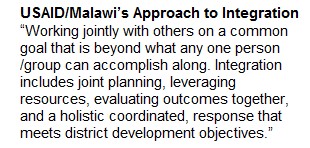Working with Partners to Continue Malawi's Activity Integration Experiment
In his previous blog, Stephen Menard, former Malawi Program Officer, described USAID/Malawi’s plans and steps taken to better harmonize their programming through a Country Development Cooperation Strategy (CDCS) integration experiment. The Mission is proactively facilitating integration through its existing Program Cycle processes. In this blog, we catch up with Stephen to learn how the experiment is going 1 year later. When we left off last time, Stephen was discussing next steps with partners as they begin to implement according to this new integration approach. Let’s see how it’s going…
USAID/Malawi has continued to roll out activity integration across the Mission’s portfolio through existing Program Cycle processes and taking the “C” in CLA to the next level. While opting to focus more intensely on collaboration, one part of the collaborating, learning, and adapting (CLA) approach, Stephen describes the effort as going “from C to 3C.” Collaboration is a key aspect of the larger 3C approach designed by the Mission, and is an iterative process in which the Mission and its partners pause and reflect on what they’ve learned through implementation.
 A key turning point in truly putting collaboration into action took place in September 2014. The Mission and its partners undertook a series of efforts to explore the implications and complexities of implementing more robust integration across Mission programming. To start, the Mission held its first portfolio review, focusing on the level of the development objective, to discuss activity integration and the complexities involved with implementation. The portfolio review was helpful in identifying successes and barriers to the process and led to a clearer definition of integration. While the Mission understood collaboration to mean building and strengthening partnerships that have the potential to make a significant difference in achieving results, the team defined integration as going a step further and “working jointly with others on a common goal.”
A key turning point in truly putting collaboration into action took place in September 2014. The Mission and its partners undertook a series of efforts to explore the implications and complexities of implementing more robust integration across Mission programming. To start, the Mission held its first portfolio review, focusing on the level of the development objective, to discuss activity integration and the complexities involved with implementation. The portfolio review was helpful in identifying successes and barriers to the process and led to a clearer definition of integration. While the Mission understood collaboration to mean building and strengthening partnerships that have the potential to make a significant difference in achieving results, the team defined integration as going a step further and “working jointly with others on a common goal.”
Second, an implementers’ workshop was organized during the same time. During these meetings, more high-level portfolio reviews were conducted to allow the Mission to reach out to stakeholders, solicit their feedback, build their buy-in, and collaborate with them as the Mission determines next steps. That next step, to adapt programming based on new learning, is much more difficult. However, the portfolio review results brought out frank, tough questions on integration that helped identify the key steps necessary to move forward and create a compelling vision for district-level leadership to ensure integrated programming sustainability.
Third, a stakeholder panel, chaired by the Country Director of the Icelandic International Development Agency with a Chief of Party from the Research Triangle Institute International and the Deputy Chief of Party from the National Democratic Institute, presented its diverse experience on decentralization and working with the local government. This panel fueled a vibrant discussion on how the Mission could attain district-level sustainability of integration. Specific points addressed by the panel included:
- How are you currently working with district government?
- What do district governments need to develop the capacity to fully lead the process of development in their districts?
- What are the practical implications of working comprehensively together at the district level?
- What can we do as development partners and implementing partners to realize this vision?
The key takeaways from this session included the need to demonstrate clear alignment of Mission activities to district development plans, ensure strong linkages between district goals and Mission activities, create ownership at the community level, and leverage local resources.
Lastly, participants conducted peer reviews of each others’ annual work plans, focusing specifically on integration according to the criteria below.
Implementing Partner Work Plan Integration Review Criteria
- Does the work plan realize cross-sectoral opportunities?
(including leveraging the technical expertise and/or interventions of USAID partners to create synergies in multiple technical areas) - Lead to added value and results?
(including the ability to reach a greater number of beneficiaries and realizing opportunities to provide cost savings) - Reflect a shared purpose?
(including sharing a stake in the process and outcome, and accessing a skill or technology not possessed by the implementer) - Reflect actions to operationalize integration?
(including joint planning, identifying clear roles and responsibilities, and facilitating formal and informal frequent communications during the planning and implementation phases) - Support district development goals?
(including using and strengthening local systems, identifying gaps, challenges, opportunities and aligning activities to district implementation plans/district development plans)
Based on the results of the peer review, partners modified and adjusted how their FY2015 work plans incorporated integration. Participatory processes like this are key to successful activity integration. By providing a real-time, collaborative environment, USAID/Malawi supports partners to share successes to date, portfolio progress, as well as implementation challenges.
CLA in Action articles are intended to paint a more detailed picture of what collaborating, learning, and adapting (CLA) looks like in practice. Unlike other disciplines, CLA is not a technical "fix;" it looks different in different contexts. This series will showcase examples of intentional collaboration, systematic learning, and resourced adaptation, some of which you may find applicable to your own work. The case studies, blogs, and resources represented in this series document the real-world experiences of development practitioners experimenting with these approaches for the benefit of sharing what's possible.



